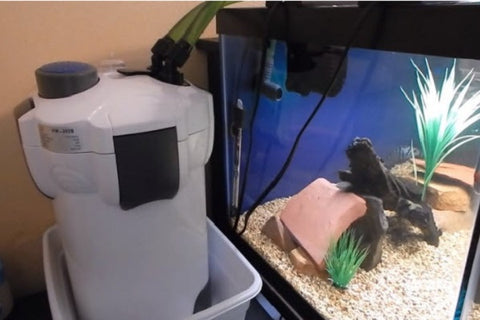An aquarium filter is one of the most important equipment in fish-keeping. It can help filter out the waste and toxins to purify the water. Moreover, it can also serve as an oxygen supplier for your fish.
But choosing the best filter for an aquarium can make you feel a headache if you know little about filters. There are various filters available in the market, such as sponge filters, power filters, canister filters and fluidized bed filters. It’s hard to tell which one is the best since the real condition is different.
In this article, we’ll help you analyze 2 of the most common filters-power filter and canister filter. We’ll start with their components and working principles. Then, you’ll know the pros and cons of them, which can help you decide which one to choose from.
Power filter
The power filter is also known as the HOB filter or hang-on-back filter. Through the name, we can know that the filter is installed outside the tank rather than submerge in the water. But there is a tube submerged into the water to siphon the dirty water.
Components
The components may differ from brands and products. The following list contains just the common components used to make a power filter.
- An inlet tube
- A filter box
- Some filter media
- An internal pump
Working principle
The components of different power filters may differ but the working principles are the same.
The internal will pump the water to the filter box through the inlet tube. When the water flows into the filter box, it will go through different filter media. Then, from the outlet, we can see the crystal clear water coming out and flowing back to the aquarium.
Advantages of power filter
- Economical
Compared to a canister filter, the power filter is more affordable.
- Easy to install and maintain
To stall a power filter, you just need to hang it on the tank wall, plug in and turn it on. To maintain a power filter, you just need to rinse or replace the filter media. If there is dust on the filter, you just need to use a towel to wipe it.
- Save tank space
The equipment will occupy the living space of the creatures in a tank, which makes them feel unhappy. But with a power filter, you can save space for your fish to swim freely, and you can keep more fish in your tank.
- Suitable for beginners
Compared with a canister filter, the power filter is more suitable for beginners. It is easy to operate and requires less maintenance, so they can spend their time taking care of the fish.
Disadvantages of power filter
- Water evaporation
The outlet of the power filter is near the water surface, so the water will be exposed to the air, leading to water evaporation. With time passing by, the water in your tank will be less than before and you might need to add some regularly.
- Inefficient
Although the name is power filter, it is less powerful than a canister filter. You may wait more time to get clean water with a power filter.
- Difficult to customize media
Some aquarists prefer to customize the media according to their special needs. But a power filter won’t allow them to do so.
Canister filter
A canister filter is best suited for medium to large-sized tanks, usually more than 40 gallons. Unlike the power filter, it will put 2 tubes into the water. One tube is to bring dirty water to the filter and the other is to introduce clean water to the tank.

Components
- An inlet tube
- An outlet tube
- A filter box
- Some filter media
- An internal pump
Working principle
The working principle is almost the same as the power filters. The pump will force the water to flow into the inlet tube. Then, the water will go through multiple filter media and flow back to the tank through the outlet tube.
Advantages of canister filter
- Save tank space
The canister filter is also positioned outside a tank, so it won’t occupy tank space like a power filter.
- Powerful
The canister filter is more efficient than the power filter. You’ll get crystal clear water in less time.
- Allow media customization
There is a large space to put filter media. Thus, the users are allowed to customize the filter media themselves. They can put mechanical, biological and chemical filter media in the filter box to realize a better effect.
- Save water
During the filtration process, the water will stay in the tube and the filter box without being exposed to air. Thus, there will be less or even no water evaporation.
Disadvantages of canister filter
- Expensive
The canister filter is powerful, durable and versatile, so there is no doubt that the price will be high.
- Noisy
It has a bigger filter box and can pump more water, thus, it will be noisier while working.
- Difficult to maintain
Except for the components listed above, there are many other components inside the filter. When you clean or maintain the filter, you need to spend some time on these components. In addition, the multiple filter media also costs you a lot to clean.
Which one is best, power filter or canister filter?
Now, I think you’ve known that we can hardly tell which one is best. It all depends on you and the real condition of your tank.
If you can’t bear the noise a filter makes, have a low budget, require a less powerful filter and don’t want to spend much time on maintaining it, the power filter would the best.
But if you want to customize the media and need a more powerful filter to remove waste, the best filter for you must be the canister filter.
Conclusion
When we have many choices, the decision-making process will be harder. But if you are more clear about what you need and know everything about the choices you have, things will be easier.
This article helps you cut countless options into 2. Furthermore, it analyses the specific information of these two filters. Now, the only thing you need to do is to figure out your requirements. You can try to make a list and use it to choose the one that satisfies more needs.
Hope you can find the one that suits you best after reading this article. If you have any questions about the filter or other aquarium products, you can leave a comment. We will help solve your problem once we see your comment.



Comments (0)
Back to Supplies & Equipment